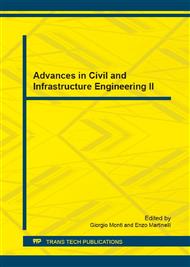[1]
SEAOC Vision 2000, Conceptual framework for performance based seismic engineering of building. Structural Engineering Association of California, Sacramento, CA, USA, (1995).
Google Scholar
[2]
Ghobarah A. Performance-based design in earthquake engineering: state of development, Engineering structures 2001; 23(8): 878-84.
DOI: 10.1016/s0141-0296(01)00036-0
Google Scholar
[3]
Priestley MJN, Seible F, Calvi GM. Seismic design and retrofit of bridges. New York: John Wiley and Sons, Inc., (1996).
DOI: 10.1002/9780470172858
Google Scholar
[4]
Kowalsky MJ. A displacement-based approach for the seismic design of continuous concrete bridges", Earthquake Engineering and Structural Dynamics 2002; 31(3): 719-47.
DOI: 10.1002/eqe.150
Google Scholar
[5]
Xue Q, Chen CC. Performance-based seismic design of structures: a direct displacement-based approach, Engineering Structures 2003; 25(14): 1803-13.
DOI: 10.1016/j.engstruct.2003.08.003
Google Scholar
[6]
Priestley MJN, Calvi GM, Kowalsky MJ. Displacement-based seismic design of structures , IUSS Press, Pavia, Ital, (2007).
Google Scholar
[7]
Jiang H, Zhu X. Energy input design spectra for near-fault regions and application in energy-based seismic design, Earthquake Engineering and Engineering Vibration 2006; 26(5): 102-108. (in Chinese).
Google Scholar
[8]
Khashaee P. Damage-based seismic design of structures, Earthquake Spectra 2005; 21(2): 371-87.
DOI: 10.1193/1.1896366
Google Scholar
[9]
Sreekala R, Lakshmanan N, Muthumani K, Gopalakrishnan N, Prasad AM. Development of a simplified damage model for beams aiding performance based seismic design, Advances in Structural Engineering 2011; 14(2): 307-18.
DOI: 10.1260/1369-4332.14.2.307
Google Scholar
[10]
Wen YK. Reliability and performance-based design, Structural Safety 2001; 23(4): 407-28.
Google Scholar
[11]
Bertero RD, Bertero VV. Performance-based Seismic Engineering: The need for a reliable conceptual comprehensive approach, Earthquake Engineering and Structural Dynamics 2002; 31: 627-52.
DOI: 10.1002/eqe.146
Google Scholar
[12]
Deierlein GG, Krawinkler H, Cornell CA. A framework for performance-based earthquake engineering, In: Proceedings of 2003 Pacific Conference on Earthquake Engineering, Christchurch, New Zealand, 2003: 1-8.
Google Scholar
[13]
Porter KA. An overview of PEER's performance-based earthquake engineering methodology, In: Proceedings of Ninth International Conference on Applications of Statistics and Probability in Civil Engineering, San Francisco, USA, 2003: 1-8.
Google Scholar
[14]
Moehle J, Deierlein GG. A Framework Methodology for Performance-Based Engineering. In: Proceedings of 13th World Conference on Earthquake Engineering, Vancouver B C, Canada, 2004: 1-6.
Google Scholar
[15]
Conte JP, Zhang YY. Performance based earthquake engineering: application to an actual bridge-foundation-ground system, In: 12th Italian National Conference on Earthquake Engineering, Pisa, Italy, 2007: 1-18.
Google Scholar
[16]
Wu QY, Zhu HP, Fan J. Performance-based seismic financial risk assessment of reinforced concrete frame structures, Journal of Central South University of Technology, 2012; 19(5): 1425-36.
DOI: 10.1007/s11771-012-1159-2
Google Scholar
[17]
Mackie KR, Lu JC, Elgamal A. Performance-based earthquake assessment of bridge systems including ground-foundation interaction, Soil Dynamics and Earthquake Engineering 2012; 42: 184-96.
DOI: 10.1016/j.soildyn.2012.05.023
Google Scholar
[18]
Padgett JE, Nielson BG, Desroches R. Selection of optimal intensity measures in probabilistic seismic demand models of highway bridge portfolios, Earthquake Engineering and Structural Dynamics 2008; 37: 711-25.
DOI: 10.1002/eqe.782
Google Scholar
[19]
Han SW, Wen YK, Method of reliability-based seismic design. I: Equivalent nonlinear systems, Journal of Structural Engineering ASCE 1997; 123: 256-63.
DOI: 10.1061/(asce)0733-9445(1997)123:3(256)
Google Scholar
[20]
Bazzurro P. Probabilistic Seismic Demand Analysis, PhD Thesis, Department of Civil and Environmental Engineering, Stanford University, Stanford, (1998).
Google Scholar
[21]
Shome N. Probabilistic seismic demand analysis of nonlinear structures, Ph.D. Thesis, Department of Civil and Environmental Engineering, Stanford University, Stanford, (1999).
Google Scholar
[22]
Luco N. Probabilistic seismic demand analysis, SMRF connection fractures, and near source effects, Ph.D. Thesis, Department of Civil and Environmental Engineering, Stanford University, Stanford, (2002).
Google Scholar
[23]
Vamvatsikos D, Cornell CA. Incremental dynamic analysis, Earthquake Engineering and Structural Dynamics 2002; 31(3): 491-514.
DOI: 10.1002/eqe.141
Google Scholar
[24]
Gardoni P, Mosalam KM, Kiureghian AD. Probabilistic seismic demand models and fragility estimates for RC bridges, Journal of earthquake engineering, 2003, 7(1): 79-106.
DOI: 10.1080/13632460309350474
Google Scholar
[25]
Huang Q, Gardoni P, Hurlebaus S. Probabilistic seismic demand models and fragility estimates for reinforced concrete highway bridges with one single-column bent, Journal of engineering mechanics 2010; 136(11): 1340-53.
DOI: 10.1061/(asce)em.1943-7889.0000186
Google Scholar
[26]
Aslani H, Miranda E. Probability-based seismic response analysis, Engineering Structures 2005; 27(8): 1151-63.
DOI: 10.1016/j.engstruct.2005.02.015
Google Scholar
[27]
Datta D, Ghosh S. Uniform hazard spectra based on park-ang damage index, Journal of Earthquake and Tsunami 2008; 2(03): 241-58.
DOI: 10.1142/s1793431108000414
Google Scholar
[28]
Goda K, Hong HP, Lee CS. Probabilistic characteristics of seismic ductility demand of SDOF systems with bouc-wen hysteretic behaviour, Journal of Earthquake and Engineering 2009; 13(5): 600-22.
DOI: 10.1080/13632460802645098
Google Scholar
[29]
Mackie KR, Stojadinovic B. Optimal probabilistic seismic demand models for typical highway overpass bridges, Proceedings 12th European Conference on Earthquake Engineering, London, UK, 9-13 September (2002).
Google Scholar
[30]
JTG/T B02-01-2008. Guidelines for seismic design of highway bridges. Beijing: People's Communications Press. (in Chinese).
Google Scholar
[31]
OPENSEES. Open system for earthquake engineering simulation. 2009, http: /opensees. berkeley. edu.
Google Scholar
[32]
Karsan ID, Jirsa JO. Behavior of concrete under compressive loadings, Journal of the Structural Division, (1969).
DOI: 10.1061/jsdeag.0002424
Google Scholar
[33]
PEER, available from URL: http: /peer. berkeley. edu/smcat/search. html. Accessed December (2013).
Google Scholar
[34]
Available from URL: http: /www. csmnc. net/. Accessed December (2013).
Google Scholar
[35]
Lv HS, Zhao FX. Site coefficients suitable to China site category, Acta Seismologica Sinica 2007; 29(1): 67-76. (in Chinese).
DOI: 10.1007/s11589-007-0071-6
Google Scholar
[36]
Ye LP, Ma QL, Miao ZW. Study on earthquake intensities for seismic analysis of structures, Journal of Earthquake Engineering and Engineering Vibration 2009; 29(4): 9-23. (in Chinese).
Google Scholar


